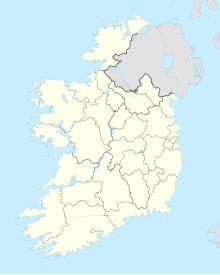Donegal County Museum
This article needs additional citations for verification. (January 2021) |
Músaem Chontae Dhún na nGall | |
 Displays within Donegal County Museum | |
 Location within Ireland | |
| Established | 1987 |
|---|---|
| Location | High Road, Letterkenny, County Donegal, Ireland |
| Coordinates | 54°57′17″N 7°44′06″W / 54.9546°N 7.7349°WCoordinates: 54°57′17″N 7°44′06″W / 54.9546°N 7.7349°W |
| Type | County museum |
Donegal County Museum (Irish: Músaem Chontae Dhún na nGall) is a county museum in County Donegal in Ireland. Located on the High Road in Letterkenny, the museum building first opened to the public in 1845 as the Warden's House of the Letterkenny Workhouse. The building was repurposed as a museum in the late 20th century.
The purpose of Donegal County Museum is to "collect, record, preserve, and display the material evidence and associated information of the History and Heritage of County Donegal".[1] In 2013, the then Minister for Arts, Heritage and the Gaeltacht, Jimmy Deenihan, said that the museum was among the "best in Ireland" at "dealing with the past and recognising all traditions [and diversity]".[2]
History[]
Workhouse[]
The museum was originally housed in what was once the warden's house of the 19th century .
The minutes of the first meeting held by Letterkenny Board of Guardians in July 1841 record that a decision has been taken to build a workhouse in Letterkenny. The new workhouse was designed by George Wilkinson. The Cork firm of Alex Deane was contracted to build it for £5,792. The flag stone for the floors was bought from Lord Abercorn's Quarry for 20p per sq. yard.[citation needed]
In early 1842 the work commenced on building of the Letterkenny Workhouse. It occupied a six-acre site and could accommodate 500 inmates. The final cost of the building was £6,450 plus £1,475 for fixtures and fittings. It was declared fit for the admission of paupers on 16 December 1844, and admitted the first inmates on 14 March 1845– before the Famine began. The first Workhouse Master and Clerk was George Langan. His wife Anne Lane became the Matron. Jane Thompson was the School Mistress. During the famine, temporary sheds were erected to accommodate fever patients. In the 1901 census, the population of the letterkenny Union was 13,080 with 6 officials and 79 inmates in the workhouse. The Workhouse later became the Letterkenny District Hospital, Fever Hospital, Births deaths and Marriages and other purposes. A dispensary was attached to the workhouse and later became Saint Anne's Maternity Hospital. The Workhouse building was demolished to build the Letterkenny Garda HQ. The Master's house/Entrance Block is now home to Donegal County Museum.[citation needed]
Museum opening[]
The Donegal County Museum first opened to the public in 1987.[3] It received additional European Union funding in 1989.[4]
Between 1990 and 1991, the existing building underwent renovations and an extension was built.[citation needed] The extended museum was officially opened by President Mary Robinson on 14 June 1992.[4]
Later developments[]
Further renovations was carried out between 1999 and 2000, and in 2019 a new multi-functional space was opened. The museum converted an existing museum workshop into a space to accommodate a range of public events and activities, such as educational workshops, meetings, film screenings and lectures.[citation needed] These works were part funded through the Arts and Culture Capital Scheme 2016-2018 under the Department of Culture, Heritage and the Gaeltacht.[citation needed]
Contents[]
The role of Donegal County Museum is to collect, record, preserve, communicate and display for the use and enjoyment of the widest community possible, the material evidence and associated information of the history of County Donegal. In Ireland, an official "County Museum" is one that is operated and funded by a Local Authority. Donegal County Museum is one of thirteen local authority-operated County Museums in Ireland.[citation needed]
The museum holds a collection of original artefacts that have a connection to County Donegal. These items cover subjects such as archaeology, history, social history and folklife.[citation needed]
The first floor exhibition tells the story of Donegal from prehistory to the twentieth century. Temporary exhibitions covering a range of topics and are held in the ground floor gallery throughout the year. The Museum is opened year round and is admission free.[citation needed]
An "event and education and outreach" programme also runs throughout the year on a variety of themes and topics.[citation needed]
Designated Museum[]
Donegal County Museum is a "Designated Museum" which, under the National Monuments (Amendment) Act, 1994, and the National Cultural Institutions Act, 1997, is entitled to retain objects on behalf of the state.[5] All archaeological objects found with no known owner belong to the state, and if the object is primarily of local importance it may be kept in Donegal County Museum for educational or display purposes.[citation needed]
References[]
- ^ "Donegal County Museum". bordermuseums.ie. Archived from the original on 21 April 2010.
- ^ "Donegal County Museum 'best in Ireland' says Minister". Donegal Daily. 5 March 2013. Retrieved 5 March 2013.
“Donegal is years ahead of everyone else when it comes to diversity, dealing with the past and recognising all traditions. The work of the County Museum is the best in Ireland when it comes to that,” he added.
- ^ "Donegal County Museum". Lough Foyle Ferry website. Archived from the original on 19 October 2007.
- ^ Jump up to: a b "Músaem Condae Dhún na nGall / Donegal County Museum". Dun-na-nGall.com. Archived from the original on 7 December 2006.
- ^ "Donegal County Museum Brochure" (PDF). bordermuseums.ie. Archived from the original (PDF) on 14 January 2014.
- 1987 establishments in Ireland
- Buildings and structures in Letterkenny
- History of Letterkenny
- Local museums in the Republic of Ireland
- Museums established in 1987
- Museums in County Donegal


